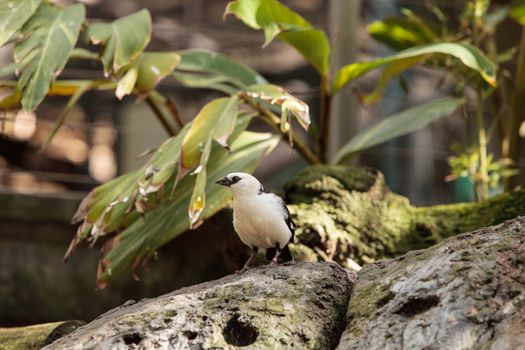ANIMAL: White-Headed Buffalo Weaver Dinemellia dinemelli Type of Animal: Songbird Habitat: Savanna, shrubland, dry brush, acacia thickets, dry bush, open thornscrub, acacia woodland/forest, grassland, not found above 4,593.176 ft Location(s): E Africa Appearance: White head/belly, orange-red rump/undertail coverts, dark brown thighs, conical black bill, tail brown in N part of range & black in S part of range, very dark brown to black back Food/Diet: Insects, seeds, fruit, vegetables Status in Wild: Stable Conservation: Breeding in zoos & wildlife centers Lifestyle: Small flocks of 3-12 birds. Breed as single pairs or in loose colonies of 3-6 pairs. Additional Info: Called: Male: Cock Female: Hen Young: Chick Group: Flock/Colony Weight: Male: 3 oz Female: 2 oz Gestation: 2 weeks Life Span: 20 years Height: Male: 7.5 in Female: 6.7 in Body Length: Male: 7.5 in Female: 6.7 in Tail Length: 6 in, same for both sexes Main predators are predatory birds, snakes, monitor lizards, & carnivorous/omnivorous mammals. Females lay 2-5 light green/blue w/ brown speckled eggs. Chicks fledge at 3 weeks but stay for up to a month longer. Sexually mature at 10 months. Courtship involves pair raising/lowering themselves simultaneously while perching. Wings extend to show white areas under flight feathers. Both sexes vocalize. Very vocal birds, especially in breeding season. Loudest call is harsh, parrot-like call. Strong bill comes in handy for cracking open hard seeds. Fun Fact(s): Very bold birds, often throwing bark/small twigs at challengers, including species much larger than them. Sometimes steal material from nests of own species as well as other species. Like most weavers, they’re known for their elaborate nests-pair gathers sticks 1st creating thorny outer protective wall-then grass/other soft materials added to build large nest w/ several rooms w/ entrance on bottom. Large trees often have multiple nests, including w/ other species. Sometimes, other species use weaver nests instead of building their own (including African Pygmy Falcons-a primary predator of weavers-even though they’re same size). Nests about size of basketball. Called Buffalo Weavers due to habit of following buffalo, eating insects they displace.

